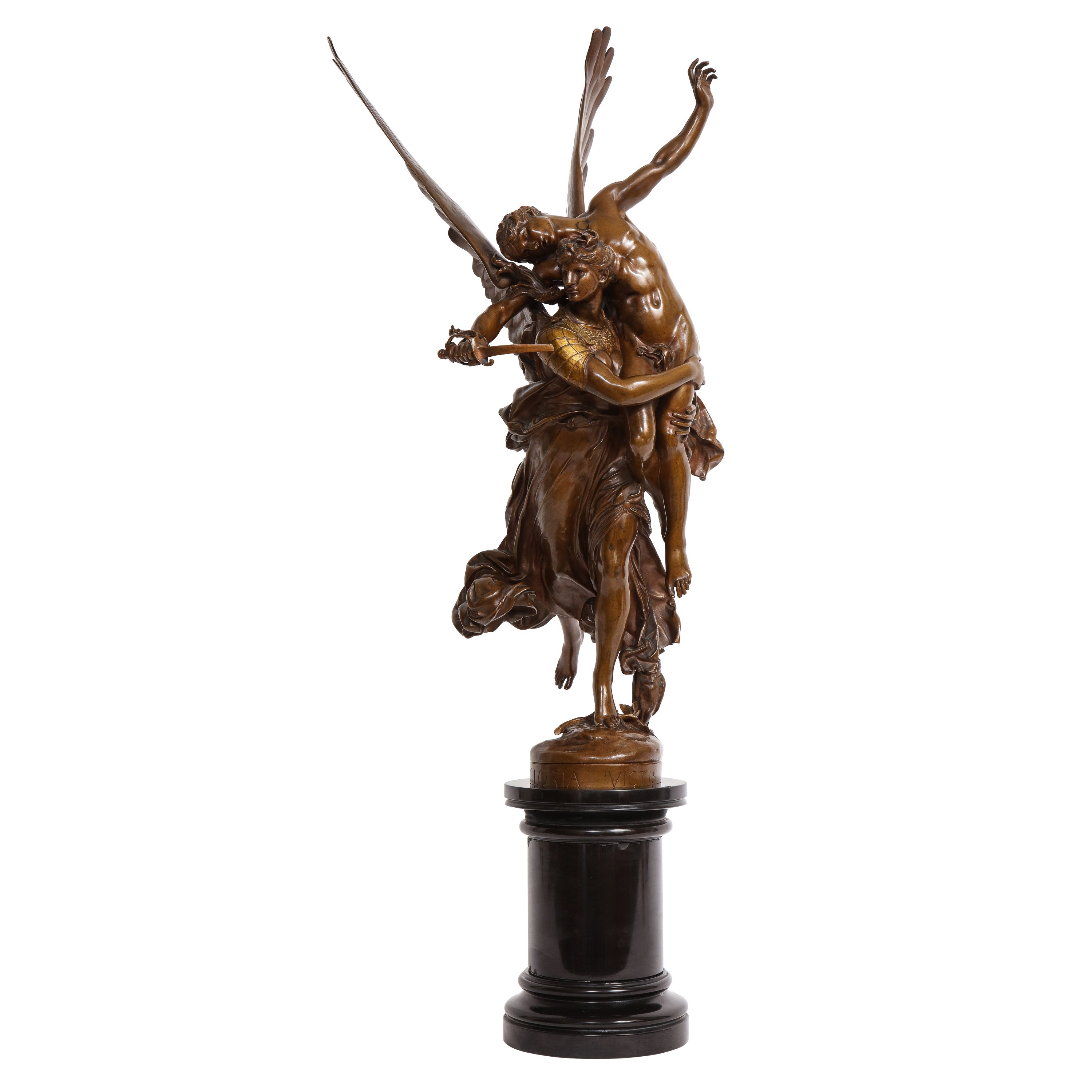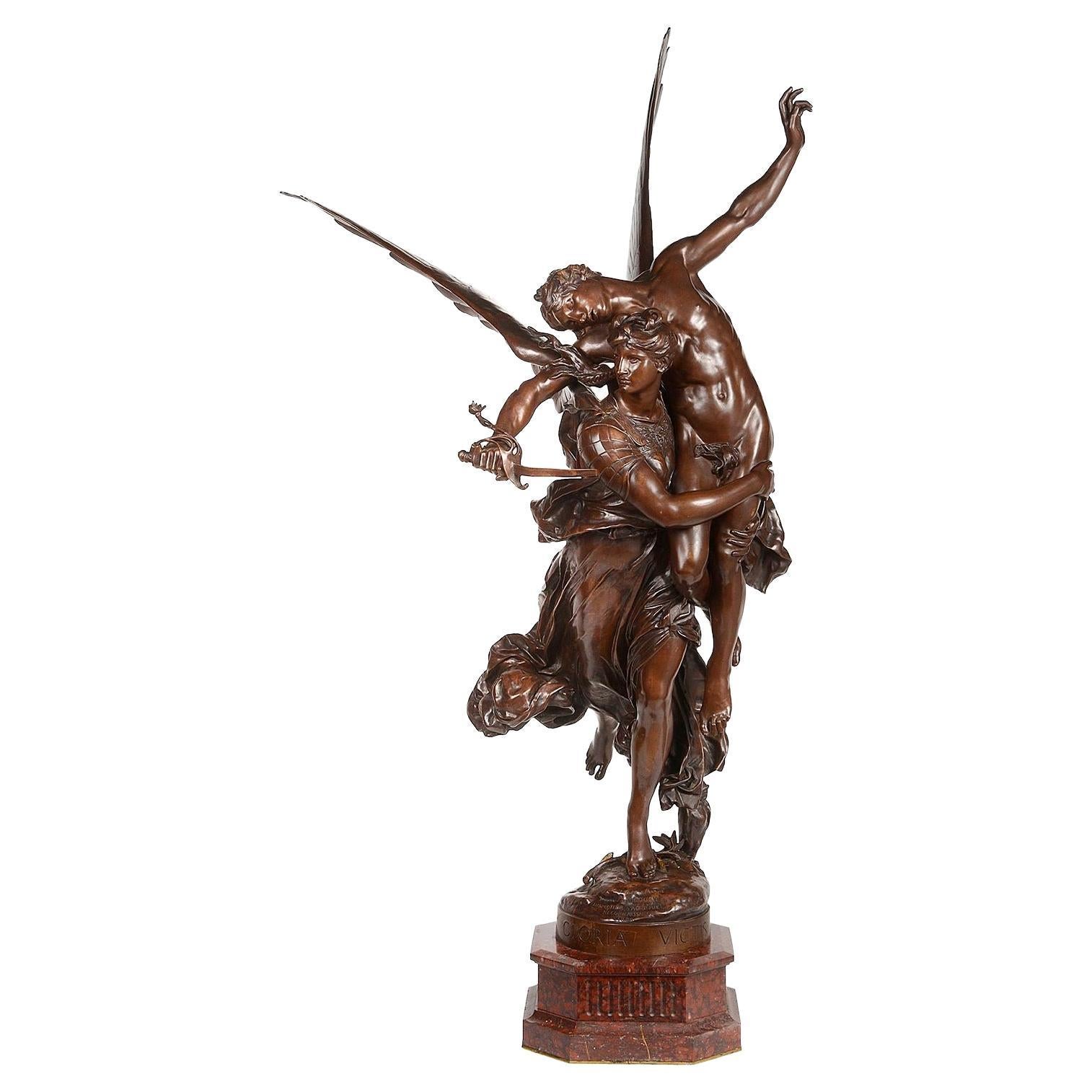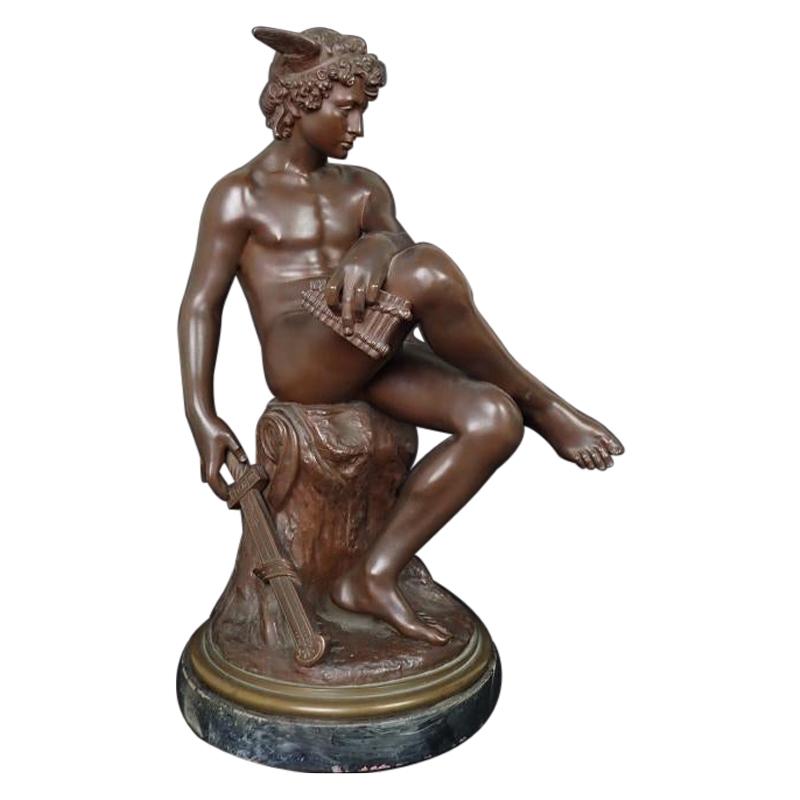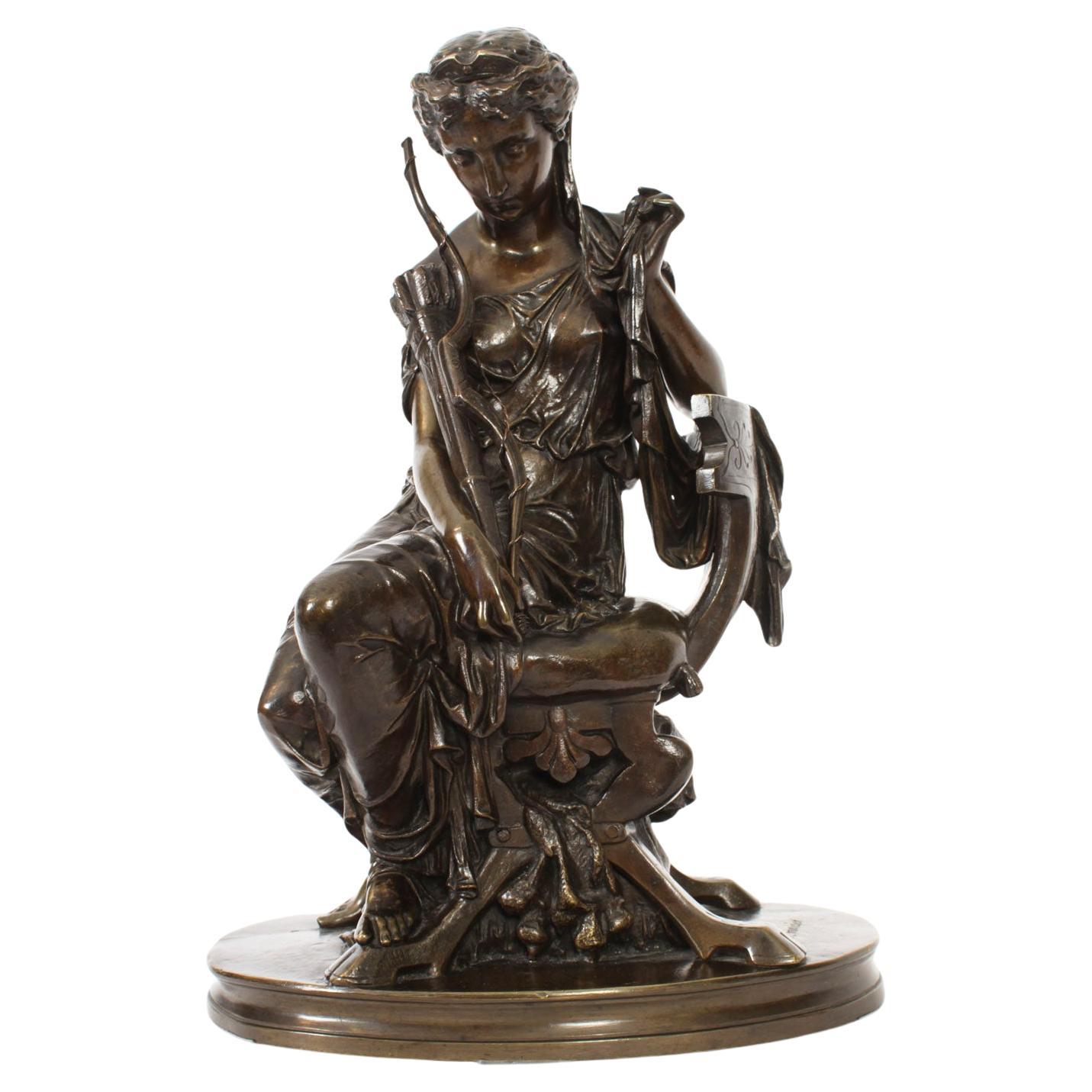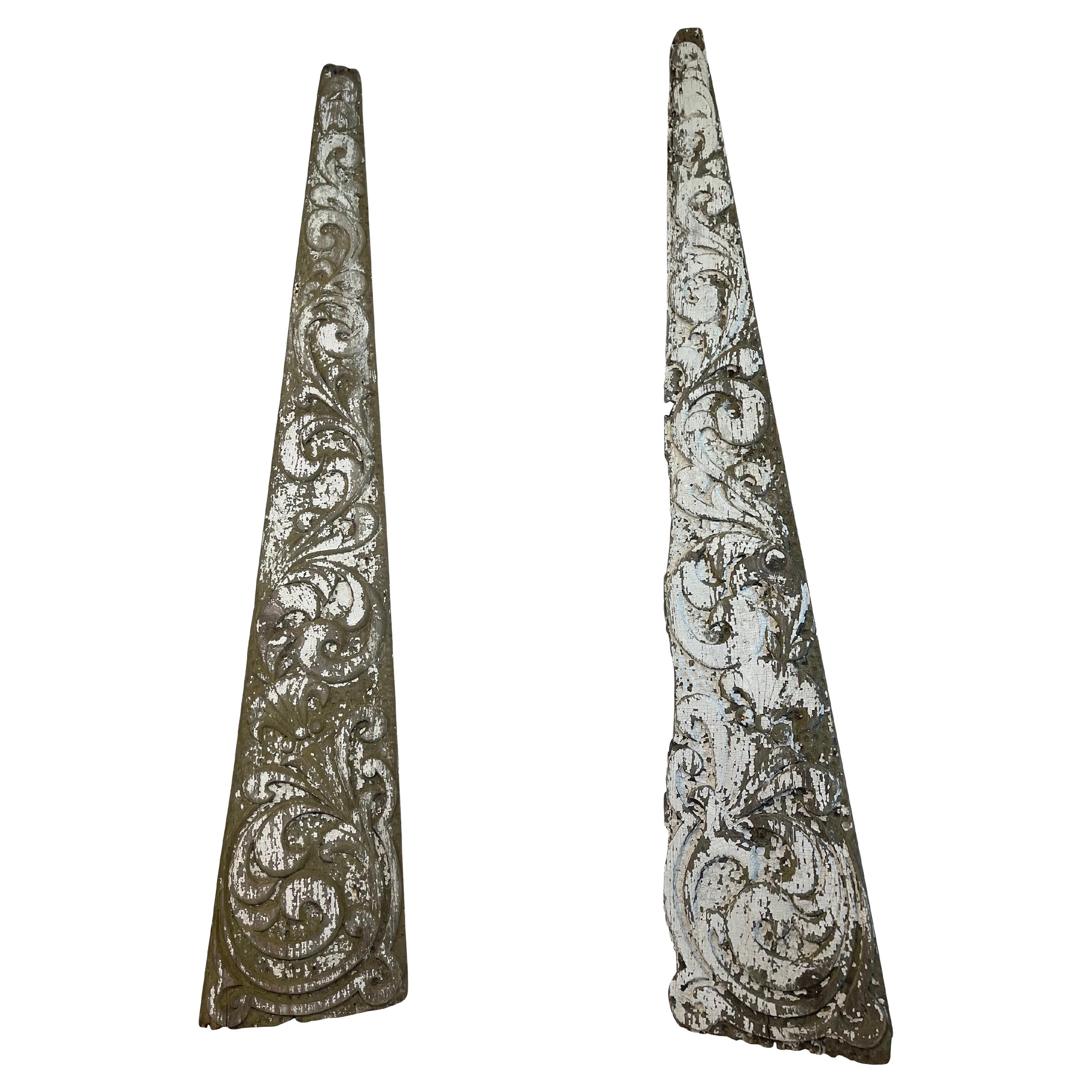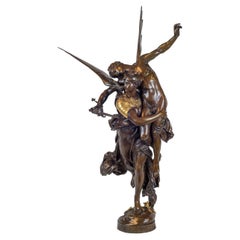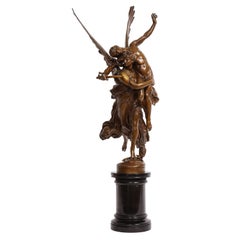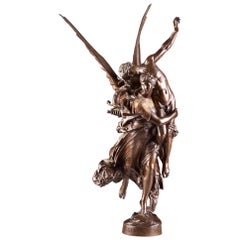
Marius-Jean-Antonin Mercié 1845-1916, "Gloria Victis", 19th Century
View Similar Items
1 of 11
Marius-Jean-Antonin Mercié 1845-1916, "Gloria Victis", 19th Century
About the Item
- Creator:Antonin Mercie (Sculptor)
- Dimensions:Height: 27.96 in (71 cm)Width: 14.18 in (36 cm)Depth: 8.27 in (21 cm)
- Style:Neoclassical (Of the Period)
- Materials and Techniques:Bronze,Cold-Painted
- Place of Origin:
- Period:
- Date of Manufacture:1890
- Condition:
- Seller Location:Ulestraten, NL
- Reference Number:1stDibs: LU5020121964792
You May Also Like
- Bronze Figural Sculpture of Gloria Victis by Antonin MerciéBy Antonin Mercie, F. Barbedienne FoundryLocated in New York, NYGloria Victis, a winged figure of victory carrying a fallen warrior casted in bronze with brown patina. Inscribed with 'F. Barbedienne. Fonduer' mark and...Category
Antique 19th Century French Figurative Sculptures
MaterialsBronze
- French 19th C Gilt and Patinated Bronze Group of Gloria Victis, by A. MercieBy F. Barbedienne Foundry, Antonin MercieLocated in New York, NYAn Incredible and Large Gilt and Patinated Bronze Group of Gloria Victis, a Winged Figure of Victory with a Fallen Warrior. This incredible bronze piece was cast after a model by Maarius-Jean-Antonin Mercié, This model is signed 'F. BARBEDIENNE FONDEUR PARIS' demonstrating that it was cast by Ferdinand Barbedienne's foundry, the best bronzier of the 19th century. The base is further signed 'A. Mercie' and stamped 'Réduction Mécanique' with an inscription of '659'. The figure is mounted on a Belgian noir marble base with various stepped edges. Gloria Victis is one the most well-known and important bronze casts of the 19th Century. The quality of this particular model is absolutely incredible and all the marking indicate that this particular piece is one of the finest produced by the Foundry. A student of Jouffroy and de Falguière at the Ecole des Beaux-Arts, Marius-Jean-Antonin Mercié (1845-1916) won the Grand Prix de Rome at 23 years old with his work Thésée vainqueur du Minotaure. In 1872, he sent the plaster model of his work David vainqueur to the Salon, for which he won the first class medal. At the same time, he received La croix de la Légion d'honneur at the Villa Medici. His return to Paris, in 1874, issued in a long and brilliant career with numerous commissions, notably the monuments for Louis-Philippe and Queen Marie-Amélie for the Royal Chapel at Dreux (1886). By the age of 30 Mercié was already very well-known and his Gloria Victis received resounding success when it was exhibited at the Salon, in 1874 (in plaster) and in 1875 (in bronze). This work exalted the heroism and the patriotic sentiments aroused by the disasters of 1870. His predilection for patriotic subjects is shown in many of his works such as Quand même...Category
Antique 19th Century French Louis XVI Busts
MaterialsBelgian Black Marble, Bronze
$23,780 Sale Price20% Off - A large 19th Century Bronze Group "Gloria Victis" by MercieLocated in Los Angeles, CAA magnificent French patinated bronze figural group entitled 'Gloria Victis' by Marius-Jean-Antonin Mercie, raised on ormolu mounted rouge marble clock base. Original rich dark patina. Mercié's original plaster sculpture of Gloria Victis won a medal at the 1874 Paris Salon. This highly detailed sculpture is Cast by Barbedienne foundry who was the leading manufacture of artistic bronzes during the second half of the 19th century, from a model by Marius-Jean-Antonin Mercie in the last quarter 19th century. One example of this piece is at the National Gallery of Art in Washington DC. Another one can be found in Bordeaux, France, where it faces Saint André's Cathedral. Signed A. MERCIÉ The base titled GLORIA VICTIS Inscribed F. BARBEDIENNE, Fondeur Paris, circa 1875 Measures: Height 44" (111 cm) Width 22" (56 ccm) Depth 18" (45 cm) The Gloria Victis sculpture...Category
Antique 19th Century French Sculptures
MaterialsBronze
- ‘Gloria Victis’, A Patinated Bronze Figural Group by Mercié, Cast by BarbedienneBy Ferdinand BarbedienneLocated in Brighton, West SussexA Patinated Bronze Figural Group of ‘Gloria Victis’ (‘Glory to the Vanquished’), Cast by Ferdinand Barbedienne from the Model by Marius-Jean-Antonin Mercié (French, 1845-1916). ‘Gloria Victis’ (‘Glory to the Vanquished’). Bronze, gilt and dark brown patina. Signed 'A. Mercié', with foundry inscription 'F. BARBEDIENNE, Fondeur. Paris.' and A. Collas reduction cachet. The integral base titled 'GLORIA VICTIS'. This cast is part of a limited edition by the Barbedienne Foundry. France. Circa 1880. ‘Gloria Victis’ is one of the most recognisable and important works of sculpture of the nineteenth century and a definitive image of France’s historic national identity. The figure of glory, winged and wearing armour, carries a dying young warrior heavenwards towards fame and immortality. The compositional daring of the group must be admired for balancing two figures on the minimal support of one foot, wings spread in the moment before taking flight. Mercié was a student at the French Academy of Rome when the Prussians invaded France in 1870. Shortly after the war had begun, he executed a group depicting the figure of Fame supporting a victorious soldier. When news reached Mercié in Rome that the French had surrendered, he decided to alter his group, replacing the victorious soldier with a defeated casualty, thus transforming an allegory of ‘Glory to the Victors’ into one of ‘Glory to the Vanquished’. Completed in 1872, a year after the defeat of French soldiers against the Prussian army, the statue personifies a defeated but heroic France. The title is also a reversal of the famous formula, ‘Vae Victis’ (Death to the Vanquished), which the Gallic general Brennus exclaimed upon defeating the Romans in 390 BC. The figure of the fallen soldier was thought to represent Henri Regnault, a fellow sculptor of Mercié who was killed on the last day of fighting. Measuring 317 cm. high the original group of ‘Gloria Victis’ was unveiled in plaster at the Salon of 1872. It was bought by the City of Paris for the sum of twelve thousand francs and then cast in bronze by Victor Thiébaut for eight thousand five hundred francs. The bronze was exhibited at the Salon in 1875 and first placed in Montholon Square in the 8th arrondissement. In 1884 it was transferred to the courtyard of the Hôtel de Ville and in 1930, it entered the collection of the Musée du Petit Palais, where it can be seen to this day. The Thiébaut Frères foundry also cast Gloria Victis bronzes for the cities of Niort (requested 1881) Bordeaux (requested 1883), Châlons-sur-Marne (today, Châlons-en-Champagne; requested 1890), and Cholet (requested 1901). In 1905, the Danish brewer and art collector Carl Jacobsen was permitted to have an exact cast made of the original sculpture in Paris, on condition that the base was made 2 cm lower and bore the inscription “Original tilhører Paris By” (The original belongs to the City of Paris). It too was cast by the Thiébaut Frères foundry. Gloria Victis was one of Jacobsen’s most important and his last acquisition. Today it has been returned to its original position in the Winter Garden at Glyptoteket, Copenhagen, Denmark. The full-size plaster was shown again at the Paris Expositon universelle of 1878 alongside a bronze reduction by Barbedienne. By this time Antonin Mercié had entered into a commercial edition contract with the Ferdinand Babedienne foundry to produce bronze reductions of Gloria Victis, his most famous work. Gloria Victis is first recorded to have been produced in three sizes and by 1886 Barbedienne’s ‘Catalogue des Bronzes D’Art’ lists six sizes measuring 3/5, 9/20, 7/20, 3/10, 6/25 and 2/10, of the original. These reductions were produced by an invention of Barbedienne’s business partner Achille Collas. The Collas reducing machine was a type of complex mechanical pantograph lathe that enabled sculpture to be mathematically measured and transcribed to scale, in the round, thus making a reduced size plaster from which a bronze could be cast. Mercié's modern sculpture had become an instant classic, even receiving an entry in the Nouveau Larousse Illustré. The success of the group undoubtedly lay in the fact that it was admired not just on an aesthetic level, but also on a patriotic level, particularly in its commemoration of heroism in defeat. Immediately ‘Gloria Victis’ was recognised as a national artwork, capable of arousing patriotism and casts were ordered from Barbedienne as local memorials commemorating the war’s dead for cities across France. ‘Gloria Victis’ was considered so much a part of France’s national identity that for the 1900 Paris Exhibition, Ferdinand Barbedienne’s nephew Gustave Leblanc, loaned a bronze example to feature as part of l’Exposition centennale de l’art français. Literature: For an interesting account of the process of creating a reduction in bronze of the Gloria Victis by Barbedienne and illustrations of the casting and finishing of the bronze see: 'Ferdinand Barbedienne': Theodore Child; Harper's new monthly magazine, Volume 73, Issue 436, September 1886. ‘Contemporary French Sculptors’: The Century, Volume 33, Issue 3, Jan 1887. ‘Modern French Sculpture’: Harper's new monthly magazine, Volume 76, Issue 452, January 1888. S, Lami, ‘Dictionnaire des sculpteurs de l'Ecole française au dix-neuvième siècle’, Tome III. G.-M., Paris, 1914, p. 432. Peter Fusco and H.W. Janson, The Romantics to Rodin: French Nineteenth Century Sculpture from North...Category
Antique 19th Century French Figurative Sculptures
MaterialsBronze
- Exceptional 19th Century Bronze Entitled ““Quand Meme” by Mercié and BarbedienneBy Ferdinand Barbedienne, Antonin MercieLocated in New York, NYA Large and Exceptional Late 19th Century Patinated Bronze Figural Group Entitled “Quand Meme” by Mercié and Barbedienne on Pedestal Marius-Jean-Antonin Me...Category
Antique Late 19th Century French Belle Époque Figurative Sculptures
MaterialsBronze
- Bronze statue of Gloria Victis, circa 1880, by BarbedienneBy F. Barbedienne FoundryLocated in Brighton, SussexA fine quality bronze sculpture of Gloria Carrying the Angel Victis, Cast by Barbedienne and After a Model by Marius-Jean-Antonin Mercie´ (French, 1845-1916). The draped figure...Category
Antique 19th Century French Figurative Sculptures
MaterialsBronze

